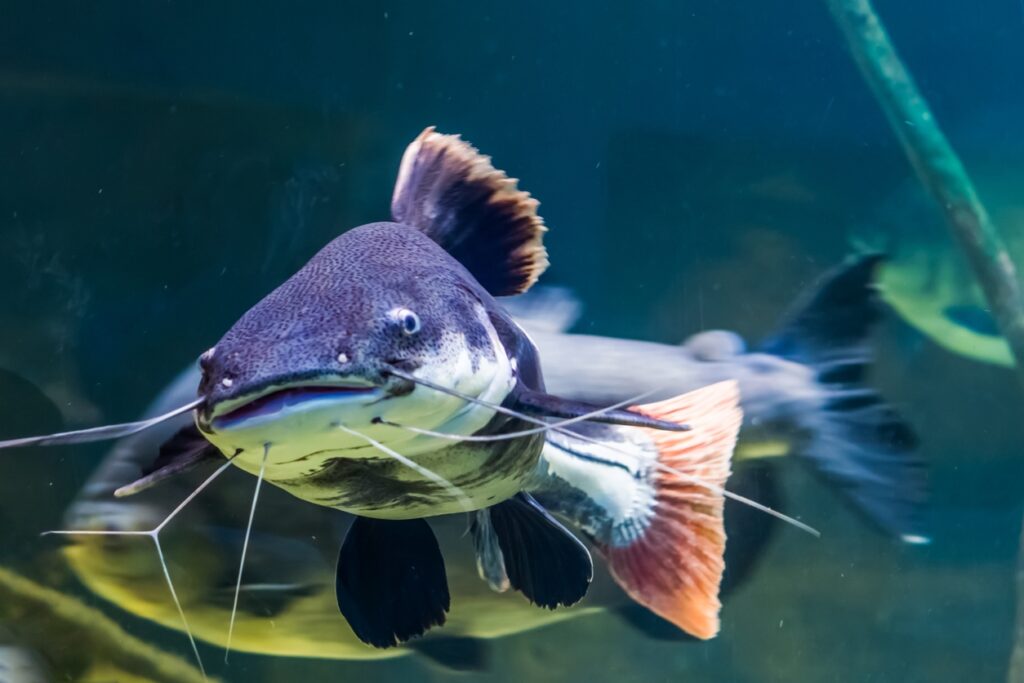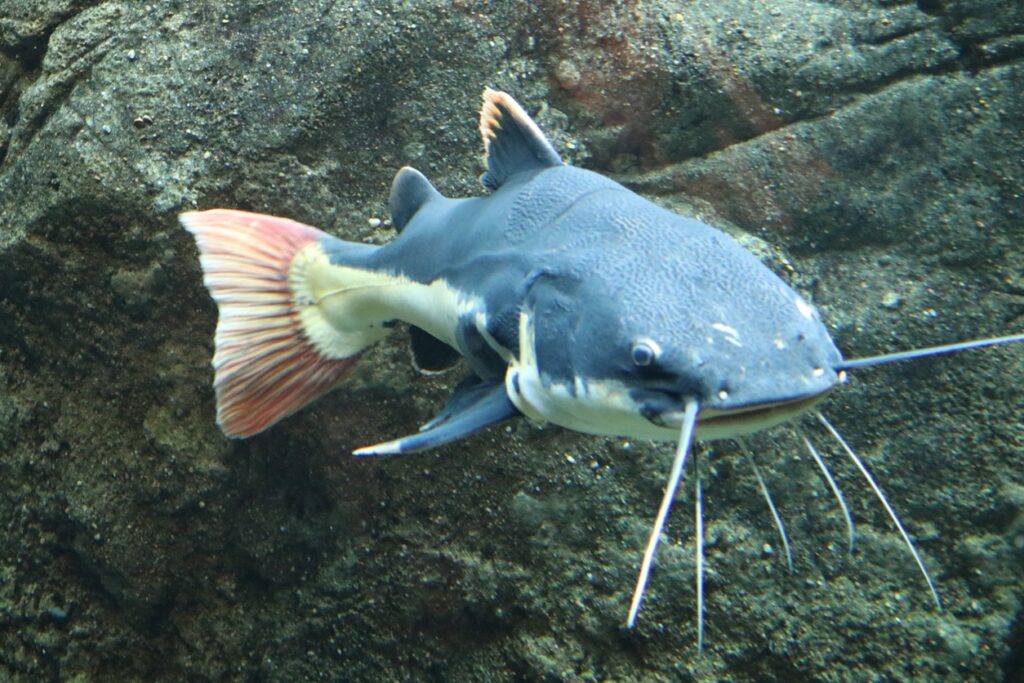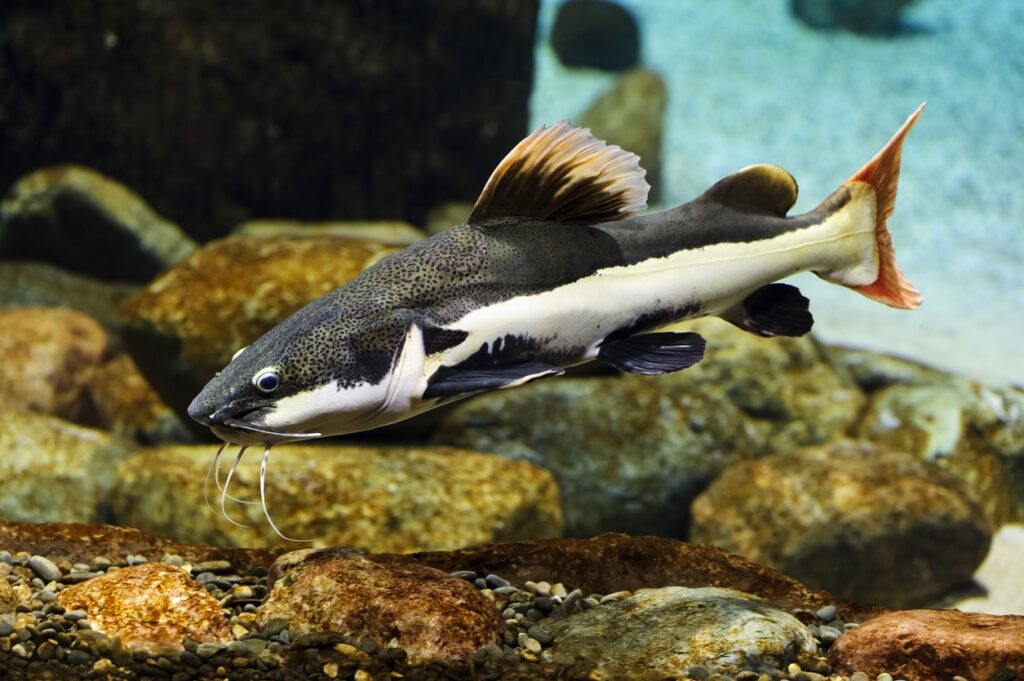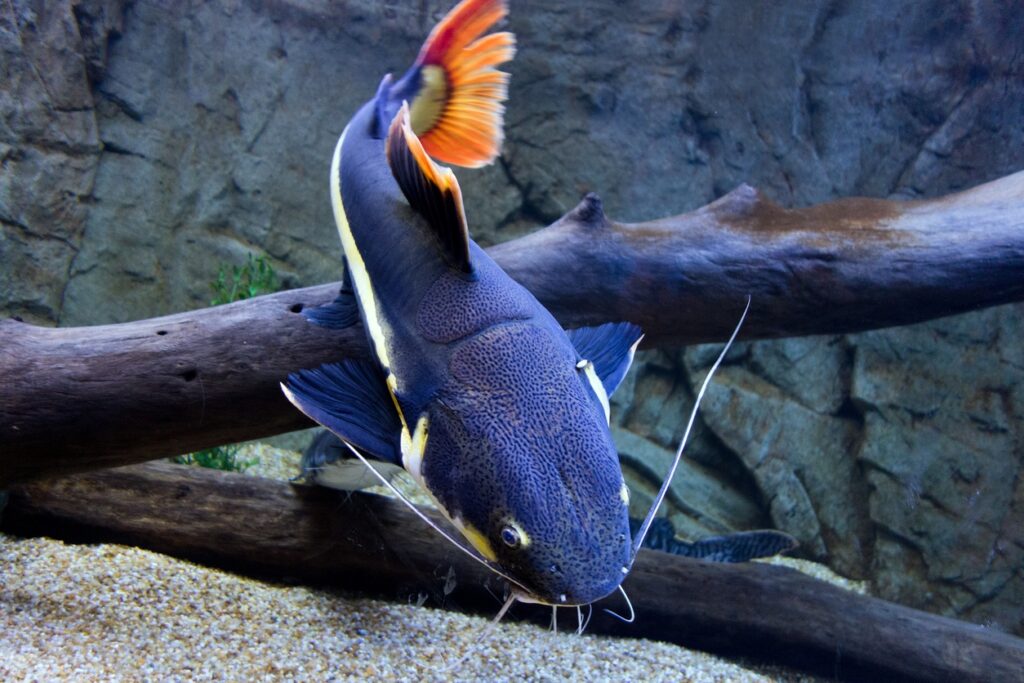Red tail catfish are a favorite of aquarists in love with monster fish. They start out small and cute but grow to be absolutely massive. And in the process of getting bigger, they often end up eating several of their tank mates. While they are not sensitive fish, all of these elements make their care very complicated.

Can you deal with a 4-foot long predator that needs hundreds to thousands of gallons of space? Let’s take a closer look at the large and in-charge redtail catfish.
Getting to Know the Red Tail Catfish
Red tail catfish are some of the largest fish that are commonly found in the aquarium trade. Native to South America, they are found mostly in Venezuelan river basins. Here they go by the local name of cajaro. And in Brazil they are known as pirarara.
In their natural habitat, they are rarely hunted for food by the locals despite being edible because their dark flesh is seen as a sign of not being of good quality. However, redtail catfish have been introduced to tropical places around the world. In Southeast Asia, they are a favorite game fish and are eaten with delight.
South American redtail catfish are members of the family Pimelodidae, which is a group of small to large catfish that are predominantly fish-eating predators. Others in the group include the much smaller Pictus Catfish and the equally long but much more slender Tiger Shovelnose Catfish.
Other Pimelodid catfish species show up in the hobby now and again. But these three fish species are by far the most common compared to the others.
You may also see the Asian Redtail Catfish (Hemibagrus wyckioides) for sale sometimes. This is a much rarer, unrelated freshwater fish species that look quite different as well.
Asian Redtail Catfish also grows huge, surpassing 4 feet in length. However, they are slimmer than “true” redtail cats and they have a pale grey body that’s nothing like the bright black and white of the South American redtail catfish.
All in all, these fish species aren’t especially difficult to care for. Redtail catfish are exceptionally hardy and eager eaters. The main issue is that they require aquariums of 500 gallons or more as they mature, something well out of reach of the average aquarist. That said, if you’re ready to take on such a challenge, you’ll have an impressive pet that will live for up to 15 years.
- Scientific Name: Phractocephalus hemioliopterus
- Origin: South America in major river basins
- Length: 4 to 6 feet
- Aquarium Size: 500+ gallons
- Temperament: Semi-aggressive; Predatory
- Ease of Care: Moderate
Redtail Catfish Care
Redtail catfish care is both easy and difficult. Easy because they are fast growers and eager eaters. They are tolerant of a wide range of aquarium water conditions and don’t need much in terms of special care. But they can also be very difficult because they grow absolutely massive and will eat most of the other fish in your tank if you aren’t careful.

Minimum Tank Size
A juvenile redtail catfish can be less than two inches long and looks adorable, with its black, white, and red patterns. But there’s no getting around the main difficulty to keeping red tail catfish: they grow fast and massive. 3 feet is on the smaller end for them, with 4 feet being a solid average. And in the unlimited confines of their home Orinoco and Amazonian River systems, they can reach up to six feet long.
Worse, that growth is incredibly quick. Redtail catfish size as a baby is just a few inches long. However, it will double its length in 2-3 months. In a year it will be fairly massive and by the next, you’ll need a yardstick to measure its length
That means the minimum tank size for an adult redtail catfish is at the very least 500 gallons in size. Probably larger, given the need for your fish to be able to turn around comfortably.
Many red tail catfish keepers place theirs in ponds – though you’d need to either be living in a tropical region or have a heated indoor pond to do so successfully.
A pond is an excellent way to provide perfect redtail catfish care because the walls can curve so they aren’t constantly running into them. Ponds hold much more water than all but the largest aquarium setup. And they offer much more space for you to choose equally large fish as tank mates for a redtail catfish.
Water Parameters for Red Tail Catfish

When it comes to water parameters red tail cats prefer conditions close to their native South American waters. That means soft conditions with moderate to low dissolved hardness (GH & KH), and moderate acidity (pH 5.5-7.0). That said, they are not picky and will continue to thrive even in the hard, alkaline water found in most tap water systems.
This adaptable nature can make them a problem in other parts of the world. So long as the conditions are right redtail catfish will survive and thrive. This can be a very big problem for local species that are not used to a new super-predator on the block.
Water temperature, on the other hand, needs to remain elevated. 74-82℉ is an ideal range for them; avoid cooling them below this point. Like all fish, red tail catfish are endothermic, meaning their bodily systems are regulated by the outside water temperature. Cold water can slow down their digestion so much that food begins to rot within, causing bloating disorders that can easily be fatal.
The main thing to watch out for is ammonia levels. Redtail catfish are massive predators with an equally massive appetite. You will be shocked by how much these fish can put away – and how much comes out the other end. This means that they continually produce large amounts of nitrogenous waste which means you’ll need a substantial filtration system to keep it all under control.
Canister filters are the only real option; even the largest power filter won’t be able to process enough water to keep ammonia, nitrite, and nitrate levels at a healthy level. A canister filter can hold a few gallons of filter media, enabling it to scrub the water free of any pollutants.
Power filters only work for baby redtail catfish, which can also be kept in smaller tank sizes. But you are only putting off the inevitable and it is better to invest in a large tank size and a proper canister filter right from the beginning.
Aquascaping for Redtail Catfish
When designing a tank for a redtail catfish space will always be the most important quality. When fully grown these freshwater fish will be able to knock over just about any decorations except for a large rock or piece of driftwood.
You can try keeping them with live plants but they are too likely to simply be uprooted accidentally over time. Plants don’t like being disturbed so often and will eventually die from being abused so often. So it’s better to stick with plastic or silk plants, which have the added advantage of not needing specialized full spectrum plant lighting.
If you are determined to keep live plants in a redtail catfish aquarium then you should stick mostly to epiphytes. These are plants that grow on hard surfaces like rocks and driftwood. And once they are established they are almost impossible to rip free.
Popular epiphytes include Java Fern and Anubias. These plants also don’t need much in terms of lighting and are great low-light plants. Aquatic mosses like Java Moss will also do well in a redtail catfish aquarium.
Sand is the best substrate for redtail catfish of all sizes. While they don’t do much digging, gravel can sometimes get swallowed alongside a live fish meal that gets pinned to the bottom. Once eaten these gravel grains can potentially block the intestinal tract, which is almost always fatal. Sand grains are small enough that, if eaten, they will be passed safely.
Another option that many redtail catfish keepers opt for is to do away entirely with a substrate. Bare bottom aquariums have a major advantage: they are extremely quick to clean! A few quick passes with the siphon hose are all that’s needed to remove the obvious feces left behind. The main drawback is that it doesn’t look nearly as nice as a tank with a substrate, though.
There is another reason why bare-bottomed tanks and ponds are so common besides ease of cleaning. By keeping things simple you won’t need to redo your aquascape every few weeks when the redtail catfish knocks things over. So be sure to take some extra time thinking about the substrate you have in mind!
Redtail Catfish Tank Mates
Choosing tank mates for redtail catfish needs to be done very, very carefully. Because these fish have a wide mouth, broad head, a giant appetite, and are active at night when most of their tank mates will be sleeping. Even fast-moving tank mates may end up disappearing, swallowed in their sleep by a hungry redtail catfish.
When small they can be kept with wide-bodied freshwater fish of equal size. Tiger Barbs, Silver Dollars, Gouramis, and Angelfish are suitable tank mates until the red tail catfish outgrows them.
But their rate of growth makes any peace very short-lived; you’ll need to be proactive about moving them to larger quarters and/or removing their edible tank mates every few months.
If you don’t want tank mates that will need to be moved lest they be eaten then choose fish that grow equally fast and that do well in a larger tank setup. Potential options include larger cichlids like Oscars and Peacock Bass. Arowanas and Stingrays are other popular tank mates that are unlikely to be eaten.
While they are voracious, red tail catfish aren’t really aggressive. They get along just fine with most large fish and even other bottom dwellers. They will ignore most of their tank mates unless it’s time to eat.
Some aquarists do report that their redtail catfish have more “personality” than most, however. That’s not uncommon for large fish, which are more intelligent and tend to recognize their owners and have strong personality quirks.
Many pimelodid catfish are outright vicious, including the well-named Black Devil Catfish (Hemibagrus wyckii). But red tails do fine with anything they can’t outright eat.
Good Tank Mates for Redtail Catfish:
- Oscars, Peacock Bass, Umbees, and other Large Cichlids
- Arowanas, Pacu, adult Plecostomus, Stingrays, and other Large Fish
Poor Tank Mates for Redtail Catfish
- Most freshwater Community Fish
Feeding Redtail Catfish
As you might expect, feeding a redtail catfish is as easy as it gets. These catfish will eat just about anything that hits the water so long as it has some meat in it! Most aquarists use a prepared pellet food formula, which is a great base for their diet.
But take the time to carefully read the ingredients label because many, if not most, brands use a lot of grain and starch-based fillers, like potato and cornmeal. Redtail catfish are predators and can’t digest all of that ground-up plant filler. You want to see fish meal, shrimp meal, and other animal protein sources as the first few ingredients.
You absolutely should offer your baby red tail catfish animal flesh as well. When small you can start out with thawed frozen brine shrimp, bloodworms, and tubifex worm masses. But as they grow insanely fast, these won’t be enough in just a few months’ time.
Many aquarists then start offering feeder goldfish, rosy reds, and guppies from their local store. While live fish are a natural food source for them, I don’t recommend taking this approach. The problem with smaller fish is that they are kept in absolutely filthy conditions where parasites, bacteria, and fungal infections are the norm.
And when your red tail catfish eats one of these feeders they are potentially going to catch those same diseases. Unless you raise your own then don’t offer diseased food to your fish…
The best redtail catfish food is fresh meaty items like shrimp, scallops, and white fish. Stay away from chicken, pork, or beef, which are much too fatty. Stick to lean seafood only.
Breeding Redtail Catfish
Unfortunately, there are few to no examples of red tail catfish breeding in a home aquarium. These fish get too large to keep multiple side by side in anything but the very largest tanks. And their sexual characteristics are entirely unknown.
It’s likely that the red tail catfish can tell male from female fish using subtle behavioral cues and hormonal releases they pick up with their sensitive whiskers. But to us they appear identical; they aren’t sexually dimorphic fish.
The breeding habits in the wild are also unknown. Many large Amazonian catfish in South America nest in mud holes along the river bank. The male will dig a nest using his tail for the female to deposit thousands of eggs within. The pair will then guard the eggs and often the fry once they’ve hatched for a few days or weeks until they grow large enough to fend for themselves.
For these reasons nearly all red tail catfish are wild-caught. Though if anyone were to breed them in captivity, it will likely be done using the methods being pioneered currently in Southeast Asia.
They keep several in a large outdoor pond in year-round tropical conditions. Sometimes hormonal injections are also used to stimulate egg and sperm production in adult fish. Since the demand for baby red tail catfish isn’t all that large there are no known captive breeding programs at present.

In Conclusion
Finally, we come to the last question: are redtail catfish right for me? Lovers of monster fish like Umbees, Pacus, and Oscars likely already know the answer – and have the space and resources required to successfully care for these mega fish.
But for the average aquarist, you should think long and hard before buying that cute baby redtail catfish from your local pet store. You may think you’ll eventually upgrade to a larger tank. But that upgrade will come a lot sooner than you think. Remember, a young red tail catfish can put on 1-2 inches of length per month.
Unless you’re absolutely certain you’re ready for the 15-year commitment that keeping redtail catfish requires, you shouldn’t give in to the impulse. Sometimes people think that they can simply take the red tail catfish to a pet store or public aquarium once it outgrows their tank.
But sadly, they are often mistaken. Pet stores and public aquariums get calls from people looking to rehome large fish on a weekly basis. They may not even have the space or resources to take on a large animal like a redtail catfish.
And letting it loose in the wild is by far the worst thing you could do. Invasive species like red tail catfish can do massive amounts of harm. They can drive local species to extinction when they eat smaller fish and introduce captive diseases to the game fish population.
These freshwater aquarium fish are unlikely to survive in all but the warmest of countries. But condemning your poor adult redtail catfish to freeze during the winter is both unkind and very irresponsible.
So think carefully; and if everything sounds good, then get ready for a fun time with a catfish that’s more like an aquatic dog than any other fish.
More Frequently Asked Questions about Red Tail Catfish
Are you still thinking hard about redtail catfish care and whether you are up to the challenge? Then you’ve come to the right place. Here are a few more frequently asked questions on how to care for an adult redtail catfish.
Redtail catfish are some of the largest fish available for a home aquarium. A small fish may be only a few inches long. But these fish grow large and they do so very fast. As an adult, a redtail catfish will be anywhere from four to six feet long.
Redtail catfish are indeed edible and as delicious as any other fish. However, in their natural habitats, they are rarely eaten because locals find their dark flesh to be offputting. There have been experiments to hybridize them with tiger shovelnose catfish in order to create a new food fish. These hybrids sometimes show up in the aquarium trade labeled as Tiger Redtail Catfish.
Redtail catfish are predators but they aren’t very aggressive. Any fish small enough to disappear into their mouth will eventually do so. But any other fish that is large enough will be safe alongside them. Large cichlids, catfish, pacu, arowanas, and other large aquarium fish are therefore the best tank mates for a redtail catfish.
Most catfish have spines with venom glands along the base and the redtail catfish is no exception. There have been no studies on the exact qualities of the venom and how dangerous it might be to humans. Most pimelodid catfish stings feel at worst like a bee sting. However, the puncture is very prone to get infected and should be cleaned and treated properly.

